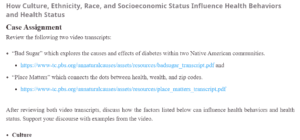How Culture, Ethnicity, Race, and Socioeconomic Status Influence Health Behaviors and Health Status
Psychological research has traditionally focused on understanding how particular behavioural, environmental, socioeconomic, physical, and biological or genetic factors can shape or influence an individual’s or community’s health and well-being. The ODPHP (Office of Disease Prevention and Health Promotion) has classified these factors as “Determinants of Health” or literally the ‘aspects that make some people unhealthy and others healthy’ (HealthyPeople.gov, n.d.). These environmental, economic, social, and personal factors are categorized into five groups: social factors, health services, policymaking, individual behaviour, and biology/genetics. The following section will discuss how social factors, specifically culture, ethnicity, race, and socioeconomic status, can impact an individual’s or community’s health behaviours and health status.
Socioeconomic status plays a significant role in determining how people (and the behaviour of people) can access critical resources in the community, such as healthy foods, medical services, quality education, transportation, living wages, job opportunities, and safe housing. All these factors can shape an individual’s or community’s health and well-being, as well as their engagement in healthy behaviours. For example, households with a higher median income (or those classified as the high-class or middle-class) will often tend to make healthy decisions or engage in healthy behaviours, such as seeking quality healthcare and better education, and will reside in safe neighbourhoods. On the contrary, those earning below the poverty line (often those in the low class) will have difficulty accessing quality and safe medical services, educational opportunities, and even safe housing.
For example, as reported by California Newsreel under the subject Place Matters, 49-year-old Gwai Boonkeut, a refugee from Laos currently living in Richmond, California, stands a lower chance of surviving from heart problems within the next few months or years (National Minority Consortia et al., 2008b). Gwai’s socioeconomic status does not give him a higher chance of resisting subsequent heart attacks. The problem is that Gwai is constantly exposed to a multitude of socioeconomic stressors, including low income, unemployment (sometimes), unsafe neighbourhoods, and so on – which are precursors of heart disease and other co-morbidities like blood pressure, diabetes, and many others. According to Dr. Donald Warne, half of the Pima and Tohono today live below the poverty line – which is the main risk factor for diabetes. Most of these individuals are unemployed and live in disadvantaged communities, which subsequently increases their risk of facing high levels of stress hormones (cortisol or epinephrine). These elevated levels of stress hormones not only affect their ability to control blood glucose levels – leading to diabetes – but expose them to co-morbidities like heart disease and hypertension.
Race and ethnicity, on the other hand, also impact the health status and well-being of a community. Ethnicity or race comprises the genetic factors that make up the biological composition of human beings. Certain racial groups, such as African Americans, can possess certain genes that can either predispose or protect them from certain conditions or diseases. For example, as narrated by Danny Lopez, a Tohono O’odham elder, most Tohonos believe that the type-2 diabetes condition runs in their lineage. When asked what the neighbours thought about the “sugar” condition in the community by Terrol Dew Johnson, his response was: “Somebody had stated, well, my mom and my sisters, they have diabetes, so I will probably get it anyway.” According to the narrator, subsequent research by the National Institute of Health has also found a direct correlation between genetic factors (especially among the Pima tribe) and the risk of diabetes (National Minority Consortia et al., 2008a).
Unlike genetic factors or ethnicity, culture affects certain communities’ attitudes, beliefs, practices, behaviours, and decisions to seek health services or engage in healthy behaviours, such as eating certain foods. For example, according to the transcript by California Newsreel on Bad Sugar, the Tohono O-Odham American Indian community has encountered the highest rates of Type 2 diabetes (roughly 50% of the community is sick, which is seven times higher than the national average) because of the beliefs and attitudes of the people towards the disease (National Minority Consortia et al., 2008a). For example, as noted by Terrol Dew Johnson, one of the leading factors that have doubled or tripled the rates of diabetes among the Tohono people is the change in culture in the last century, with the community losing their vast lands and work. Diversion of water in the upper Gila River has also played an important part in transforming the healthy behaviours and culture of the Tohono. People were unable to cultivate crops or work in the fields, forcing them to live on packed or commodity foods distributed by the US military, including canned foods, lard, refined sugar, cheese, and white flour. According to Terrol Dew Johnson, these unhealthy diets and cultural changes were the harbingers of the diabetes nightmare that wiped out almost the entire Pima and Tohono people.
References
HealthyPeople.gov. (n.d.). Determinants of health. Retrieved from https://www.healthypeople.gov/2020/about/foundation-health-measures/Determinants-of-Health
National Minority Consortia et al. (2008a). Unnatural causes: Bad sugar. California Newsreel, https://www-tc.pbs.org/unnaturalcauses/assets/resources/badsugar_transcript.pdf
National Minority Consortia et al. (2008b). Unnatural causes: Place matters. California Newsreel, https://www-tc.pbs.org/unnaturalcauses/assets/resources/place_matters_transcript.pdf
ORDER A PLAGIARISM-FREE PAPER HERE
We’ll write everything from scratch
Question
How Culture, Ethnicity, Race, and Socioeconomic Status Influence Health Behaviors and Health Status
Case Assignment
Review the following two video transcripts:
- “Bad Sugar” explores the causes and effects of diabetes within two Native American communities.
- “Place Matters”, which connects the dots between health, wealth, and zip codes.
- https://www-tc.pbs.org/
unnaturalcauses/assets/ resources/place_matters_ transcript.pdf How Culture, Ethnicity, Race, and Socioeconomic Status Influence Health Behaviors and Health Status
- https://www-tc.pbs.org/
After reviewing both video transcripts, discuss how the factors listed below can influence health behaviours and health status. Support your discourse with examples from the video.
- Culture
- Ethnicity
- Race
- Socioeconomic status
What can communities do to change the narrative and reduce health inequalities using the examples of “Bad sugar” and “Place matters” videos?
Assignment Expectations
Length: 2–3 pages (excluding the cover page and the reference list).


